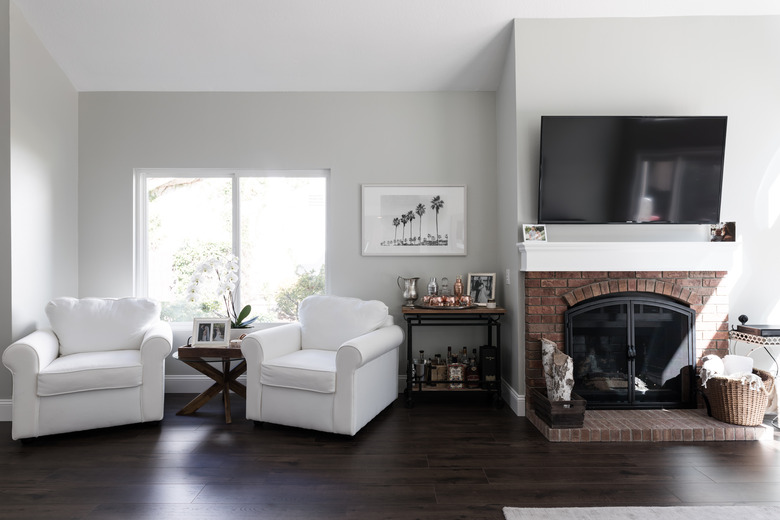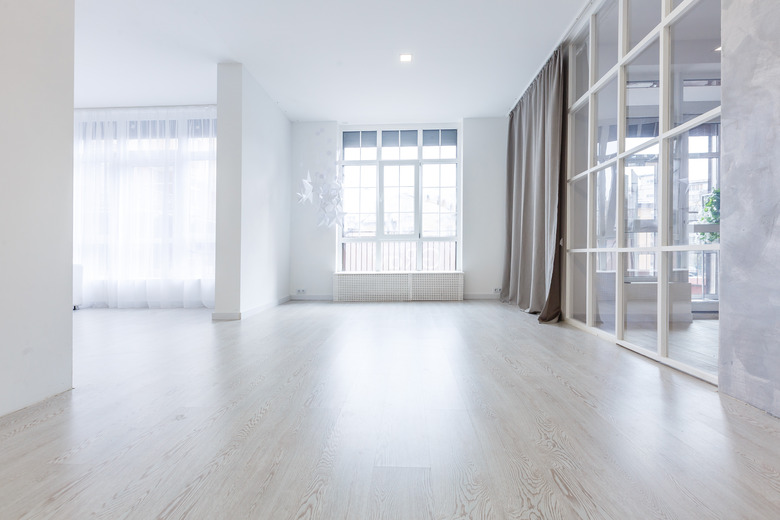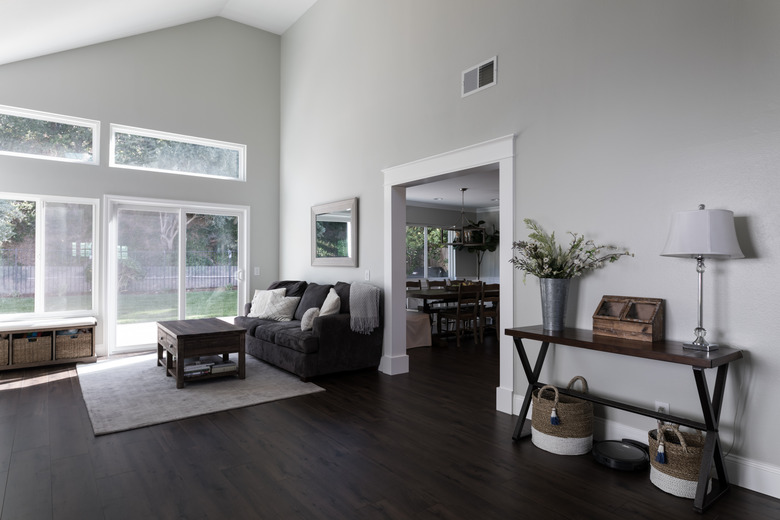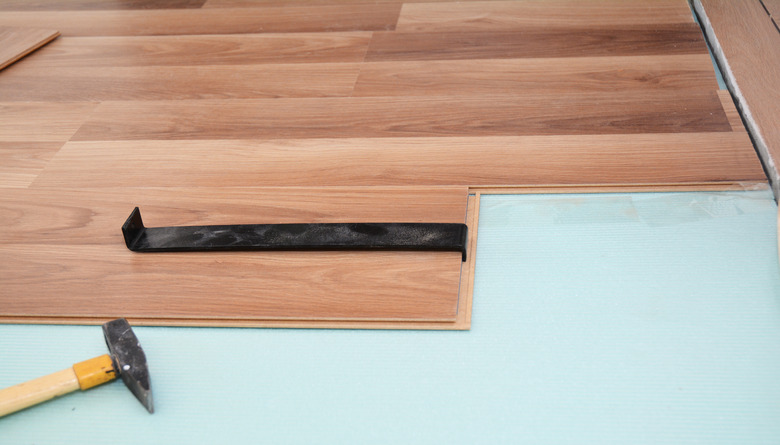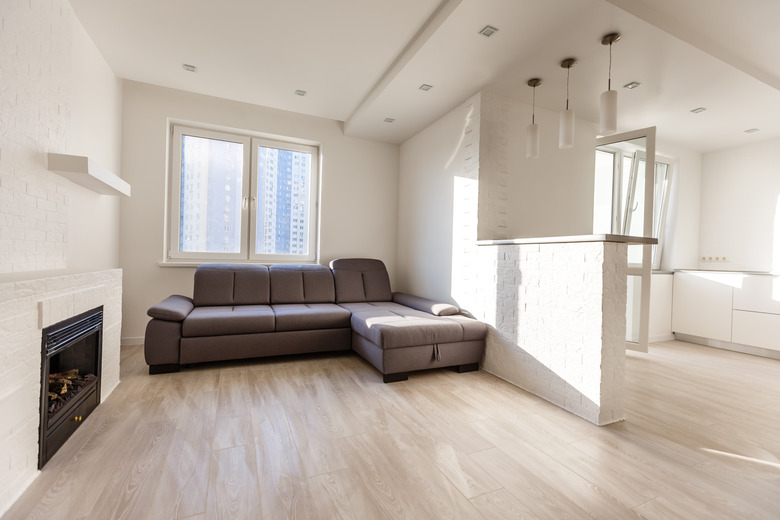Cost To Install Laminate Flooring
We may receive a commission on purchases made from links.
- Why Choose Laminate Flooring?
- Laminate Flooring Cost Considerations
- Laminate Quality Cost Guide
- Laminate Flooring Installation Cost Factors
- Underlayment for Laminate Flooring
- Cost by Laminate Feature
- Laminate Wood Versus Hardwood Flooring
- AC Rating Considerations
- Laminate Flooring AC Ratings
- Where To Buy
If you're thinking of replacing your old flooring with new laminate flooring, the financial investment required for such an endeavor is always an important consideration. The cost to install laminate flooring can vary widely depending on the flooring type and whether you decide to tackle it as a DIY project or opt for professional installation.
Doing just a little bit of homework and planning can go a long way in saving you money on the purchase and installation of new laminate flooring.
Why Choose Laminate Flooring?
Why Choose Laminate Flooring?
If you're interested in getting the most bang for your buck, laminate flooring is an ideal choice. Laminate flooring imitates the look and feel of more expensive flooring materials like wood and natural stone but costs a fraction of the price.
Laminate flooring is simple to install and maintain and can hold up well to traffic, like in your kitchen or hallways, according to Floor Critics.
Laminate Flooring Cost Considerations
Laminate Flooring Cost Considerations
Various factors can affect the installation cost of laminate flooring. First, you'll need to consider the size of the area where you plan to install your laminate flooring. Measure your existing floors to determine approximately how much you will need for your project. It's a good practice to purchase slightly more material than you think you need to account for trimmed pieces.
Quality and brand are other factors that can affect the laminate flooring cost. Some brands are more expensive than others, and every brand typically has different levels of quality from which to choose. The higher the quality of your laminate flooring, the more you can expect to pay for it.
Since the material quality typically has such a considerable impact on laminate flooring cost, it might be tempting to simply opt for the cheapest laminate available. Keep in mind, however, that the cheapest option is not always the best choice. When deciding on the level of quality you want in your laminate, you need to consider the location of the laminate installation, the type of subfloor on which it will be installed and whether you need a moisture barrier or sound control.
Even the time that you buy your laminate flooring can impact the project cost. Whether you choose to buy your laminate flooring online or in a store, buying at the right time can make a difference, too, since prices can sometimes vary seasonally. Shop around for the best values and don't forget to factor in sales tax as well as potential shipping and delivery fees.
Laminate Quality Cost Guide
Laminate Quality Cost Guide
The price range you can expect to pay for flooring materials runs somewhere between 68 cents per square foot for the most basic and inexpensive laminate to about $5 for more premium options.
Cheap laminate flooring typically has a thickness of approximately 1/8 inch, which makes the top wear layer really thin. Despite its inexpensive price point, this is the lowest quality of laminate flooring available and is not ideal for installation in high-traffic areas because it will wear down much faster than its higher-quality counterparts.
For a few dollars more, medium-quality laminate is slightly thicker at around 3/8 inch, which should afford a slightly longer shelf life before wear and tear starts to show. This midrange laminate will cost somewhere between $2 and $4 per square foot depending on the brand and where you buy it. Premium laminate flooring offers the thickest top layer and an overall plank thickness of about 1/2 inch. The laminate flooring cost for premium-quality laminate ranges between $3 and $5 per square foot.
Some laminate flooring includes a moisture barrier or underlayment attached as a bottom layer. While a moisture barrier or an attached underlayment will increase the price of your laminate flooring, the protection that each of these options adds to your floors can help save you money in the long run.
Laminate Flooring Installation Cost Factors
Laminate Flooring Installation Cost Factors
The installer, complexity of the project, subfloor condition, materials required and where you live are all factors that can impact the installation cost of your new laminate floors.
If you do your own laminate flooring installation, you can save a significant amount of money on the labor costs. Thanks to the tongue-and-groove or click-lock technology that most laminate flooring options offer, taking on laminate flooring installation as a DIY project is an attainable goal. However, if you would prefer to leave the laminate installation to a professional, you'll have to add professional installation costs to your budget. The national average for professional laminate installation ranges between $1 and $3 per square foot, in addition to your materials cost.
The complexity of the laminate installation project is another cost factor to consider. Professional installation costs will be on the higher end if the installer needs to get the laminate flooring around plumbing, electrical or HVAC equipment. Even if you are doing your own laminate flooring installation, working with small and tight spaces will cost you extra in materials because you'll need to cut planks to fit the awkward spaces.
Preparation of the subfloor or old underlayment or flooring you will install the laminate over can add to the labor and cost of the job. Old flooring or underlayment (that is, thin plywood that is laid over the subfloor — not the new rolled underlayment that goes under laminate) can be removed if it is in poor condition. If subflooring, the structural layer of the floor, is badly damaged, it may need to be replaced. Otherwise, subflooring and other materials can be leveled and smoothed in local areas with a floor leveling compound.
Remember to always leave room in your laminate installation budget for the possibility of having to purchase additional materials. Buying things like underlayment, baseboards or caulking can quickly swell both your materials and installation budget. Some professional installers charge a trip fee for traveling to your location for installation. If you hire an installer, be proactive by asking if there is a trip charge so you can factor that into your budget if necessary.
Underlayment for Laminate Flooring
Underlayment for Laminate Flooring
Underlayment is a layer of material that goes between the subfloor and your new laminate. The underlayment is a necessary component of laminate flooring installation because it provides stability and protection. If your laminate flooring does not come with an attached layer of underlayment, you'll need to factor in the cost of buying some separately.
Foam underlayment is the type most commonly used with laminate flooring, but as with any other flooring material, there are variations in the cost and available features. The most basic foam typically has a price range between 22 cents and 30 cents per square foot. Higher-quality underlays that include sound-reducing or moisture-blocking features are slightly more expensive and often run between 50 cents and 75 cents per square foot.
Cost by Laminate Feature
Cost by Laminate Feature
Laminate flooring offers a variety of different features that can influence cost. Laminate floors that are scratch resistant, for instance, are typically less expensive than laminate floors that also resist noise and water.
Scratch-resistant laminate begins at 68 cents per square foot and can run up to $2.59. The average price range for laminate floors that don't require waxing or polishing falls between 99 cents and $3.33. Noise- and water-resistant laminate flooring costs range from $1.39 to $2.79. The average cost of laminate floors that come with underlayment attached is between $1.88 and $2.79.
Laminate Wood Versus Hardwood Flooring
Laminate Wood Versus Hardwood Flooring
Laminate wood flooring is designed to mimic hardwood flooring, particularly embossed laminate, which includes surface texturing to give it a more authentic look and feel.
While it may not be the real deal, laminate wood flooring has the upper hand against authentic hardwood when it comes to both price and durability. When you compare the average cost of $1 per square foot for laminate wood and the $5 to $8 price range you can expect for hardwood, laminate is undoubtedly easier on your budget. Even the installation cost is cheaper with laminate wood than it would be for hardwood installation.
Durability is an important consideration with any flooring material. Thanks to the way it's manufactured, laminate wood is considerably harder to scratch, stain or dent than hardwood. It's also easier to maintain because it doesn't require sanding or refinishing over time. The only maintenance required for your laminate flooring is occasional surface cleaning.
AC Rating Considerations
AC Rating Considerations
When shopping around for laminate flooring, you're likely to come across AC ratings. AC stands for "abrasion class" and refers to various categories of use and durability. According to BuildDirect, these ratings are applied by the European Producers of Laminate Flooring (EPLF) and help buyers know the durability differences between laminate products.
To determine the AC rating for each laminate flooring type, the EPLF tests the laminate flooring by subjecting it to a series of burns, scratches, stains and impacts. The flooring's resistance to these tests yields an AC number that can help guide your purchasing decision. Failing even a single test can disqualify a product, so laminate flooring must successfully pass all the tests to earn its rating.
You can expect that laminate flooring with higher AC ratings will cost more than those with lower ratings, but you may not necessarily need the most expensive laminate with the highest AC rating. Some laminate flooring, for example, may be more suitable for commercial areas than residential.
Laminate Flooring AC Ratings
Laminate Flooring AC Ratings
Familiarizing yourself with what each AC rating means can help you determine which laminate flooring is most compatible with your needs and your budget.
- AC1 Moderate Residential. Laminate flooring with this AC
rating is not designed for heavy-traffic areas and is best suited for closets
or bedrooms. - AC2 General Residential. An AC2 rating on your laminate
flooring means it was designed for moderate foot traffic. Laminate with this
rating is suitable for installation in dining rooms, living rooms or other
residential spaces that typically take on moderate traffic. - AC3 Heavy Residential/Moderate Commercial. Laminate
flooring with an AC3 rating offers a solid midrange durability that works well
for any kind of residential use, including rooms with high-traffic areas.
This flooring is also compatible with some commercial spaces, like offices or
hotel rooms with light foot traffic. - AC4 General Commercial. Laminate flooring rated at this
level is built to last even when subjected to heavy foot traffic. It is
suitable for all residential use and commercial spaces with high-traffic areas,
like cafes and boutiques. - AC5 Heavy Commercial. Laminate flooring with an AC5 rating
offers the highest durability and is also the most expensive. It is designed to
withstand abuse from heavily trafficked areas, like department stores or
government buildings.
Where To Buy
Where To Buy
There are many places to buy laminate flooring. Good places to start your search are your local Home Depot or Lowe's.
References
- Floor Critics: Laminate Flooring Costs & Installation Price
- Angie's List: How Much Does It Cost To Install Laminate Flooring?
- BuildDirect: Laminate Flooring AC Ratings
- HomeGuide: Laminate Flooring Installation Cost
- HomeAdvisor: Laminate Flooring Installation Cost
- Floor Critics: Best Underlayment for Laminate Flooring
